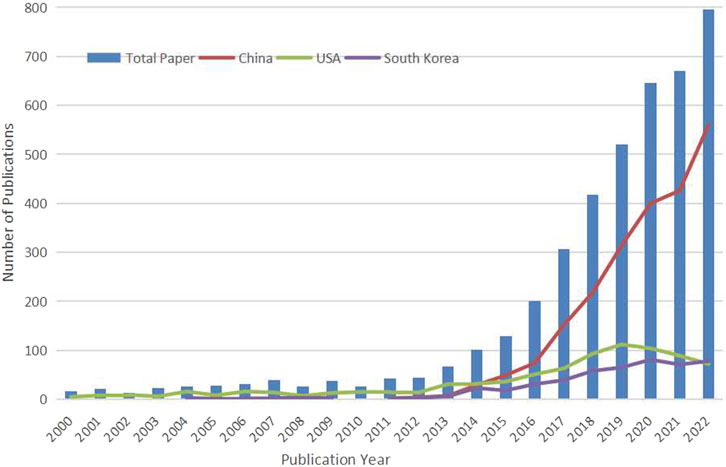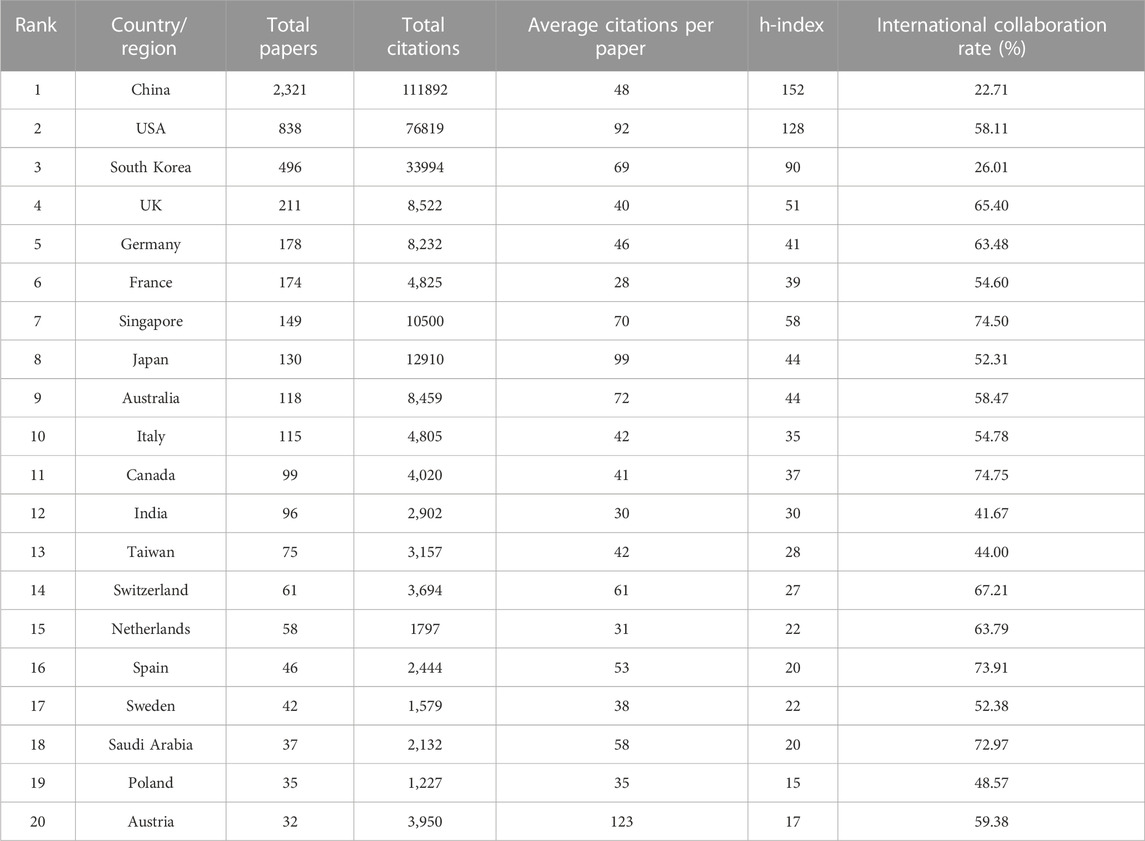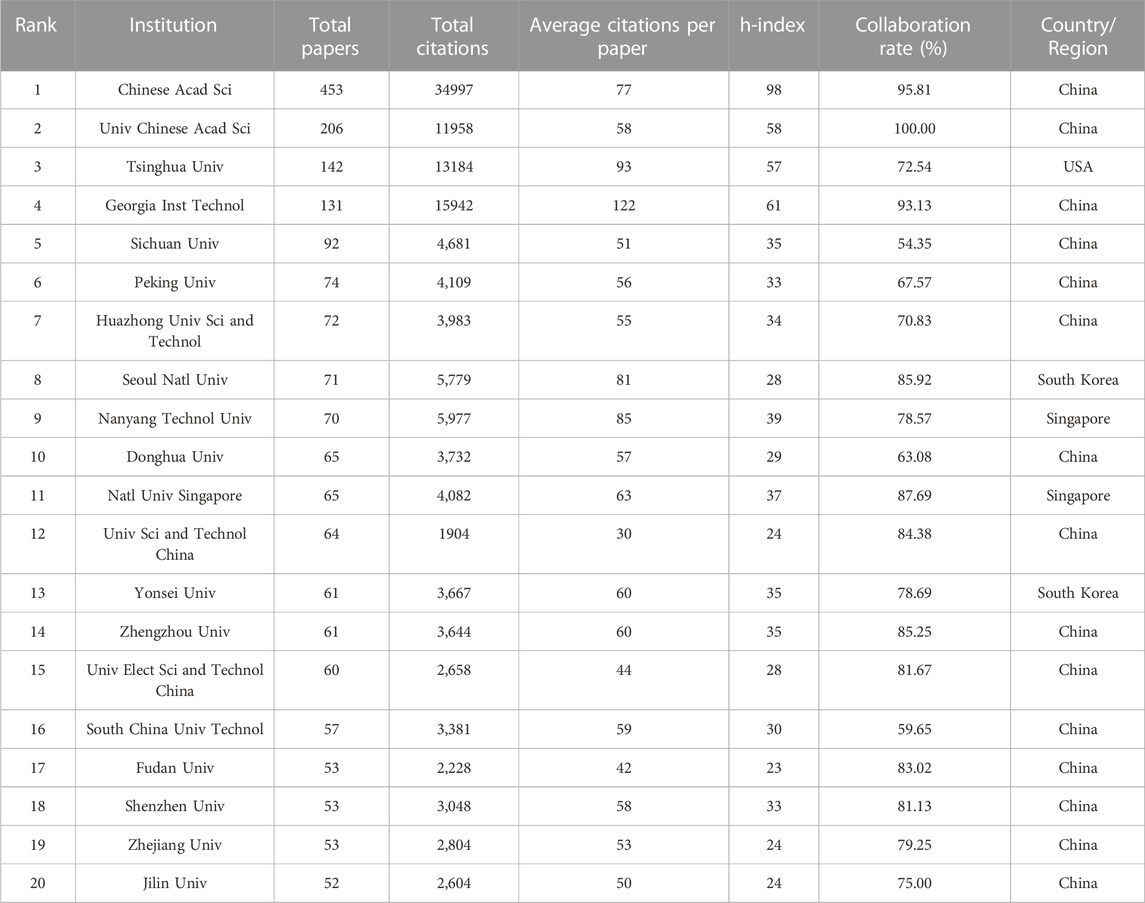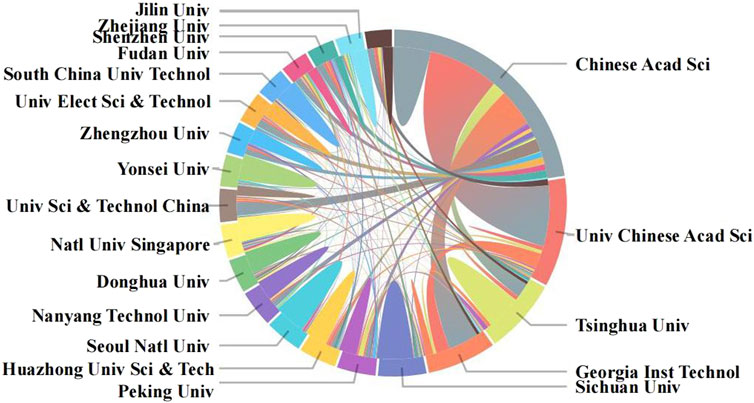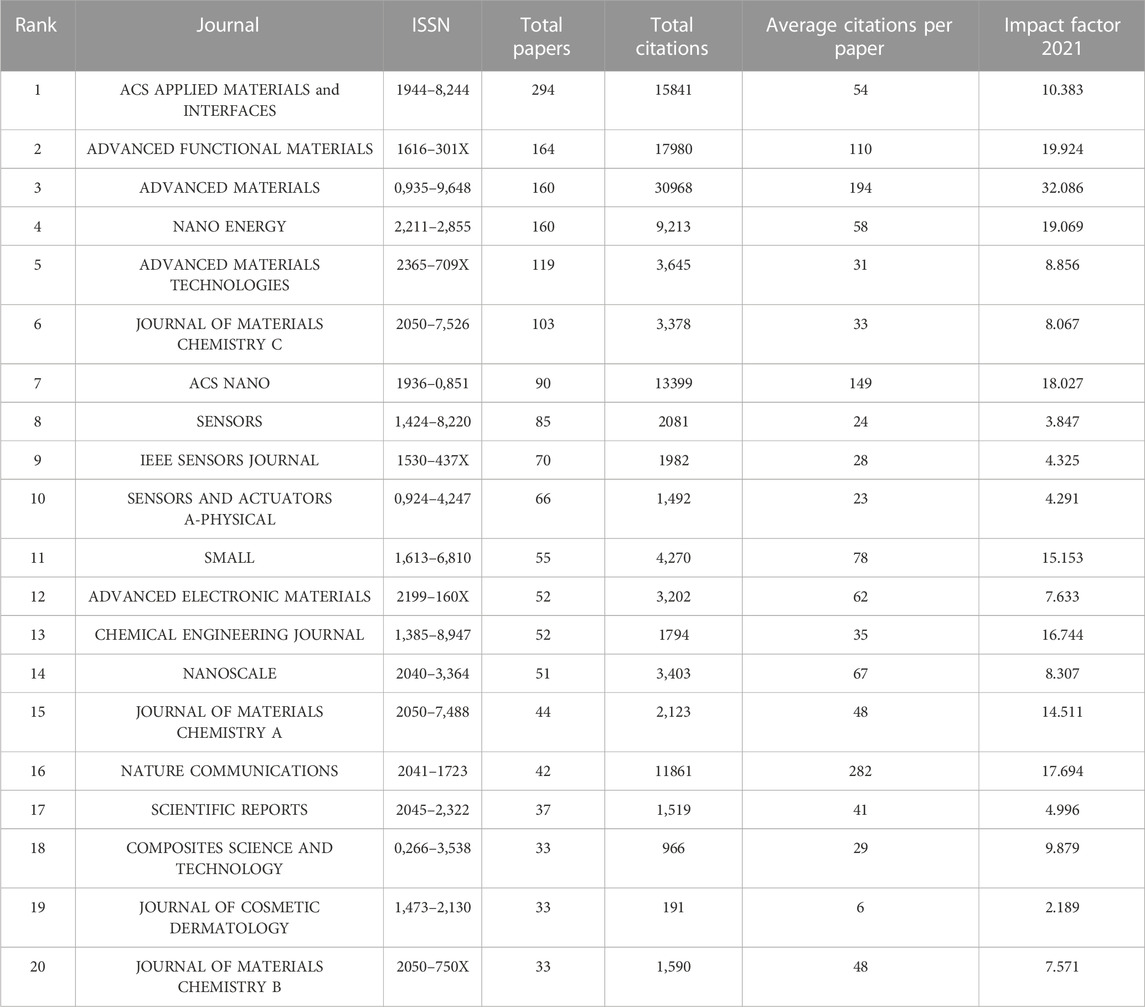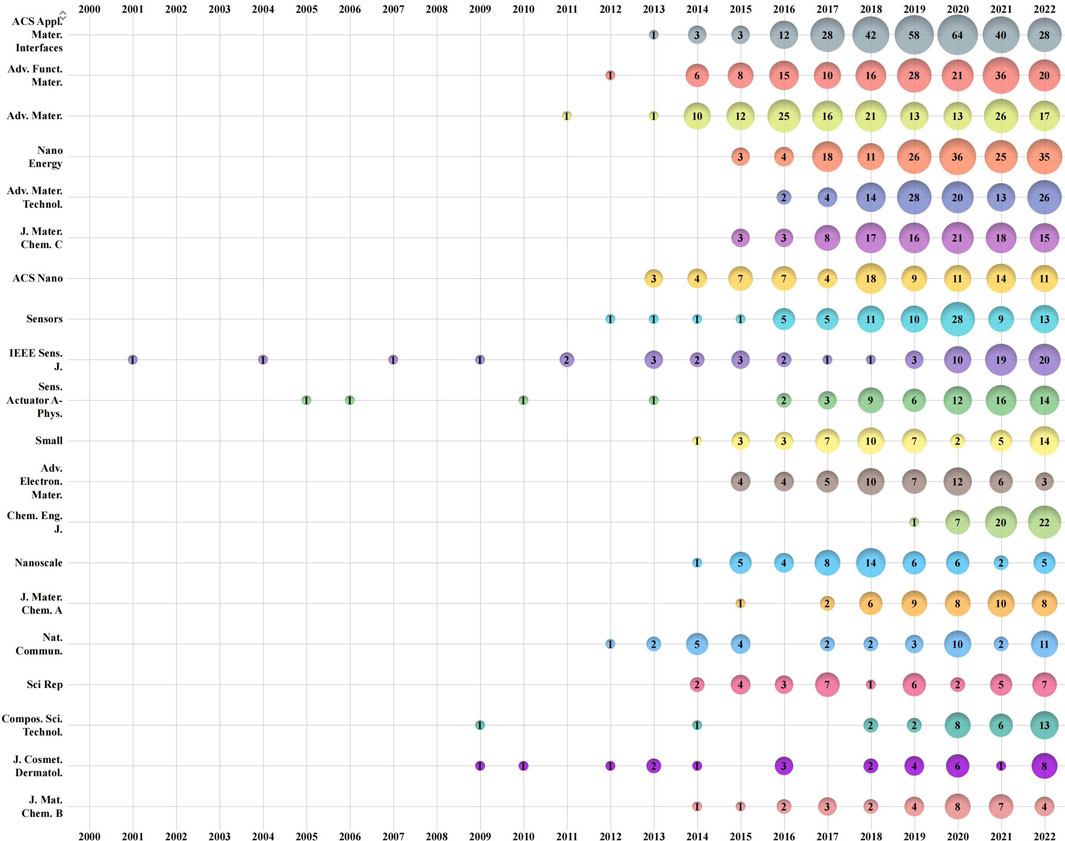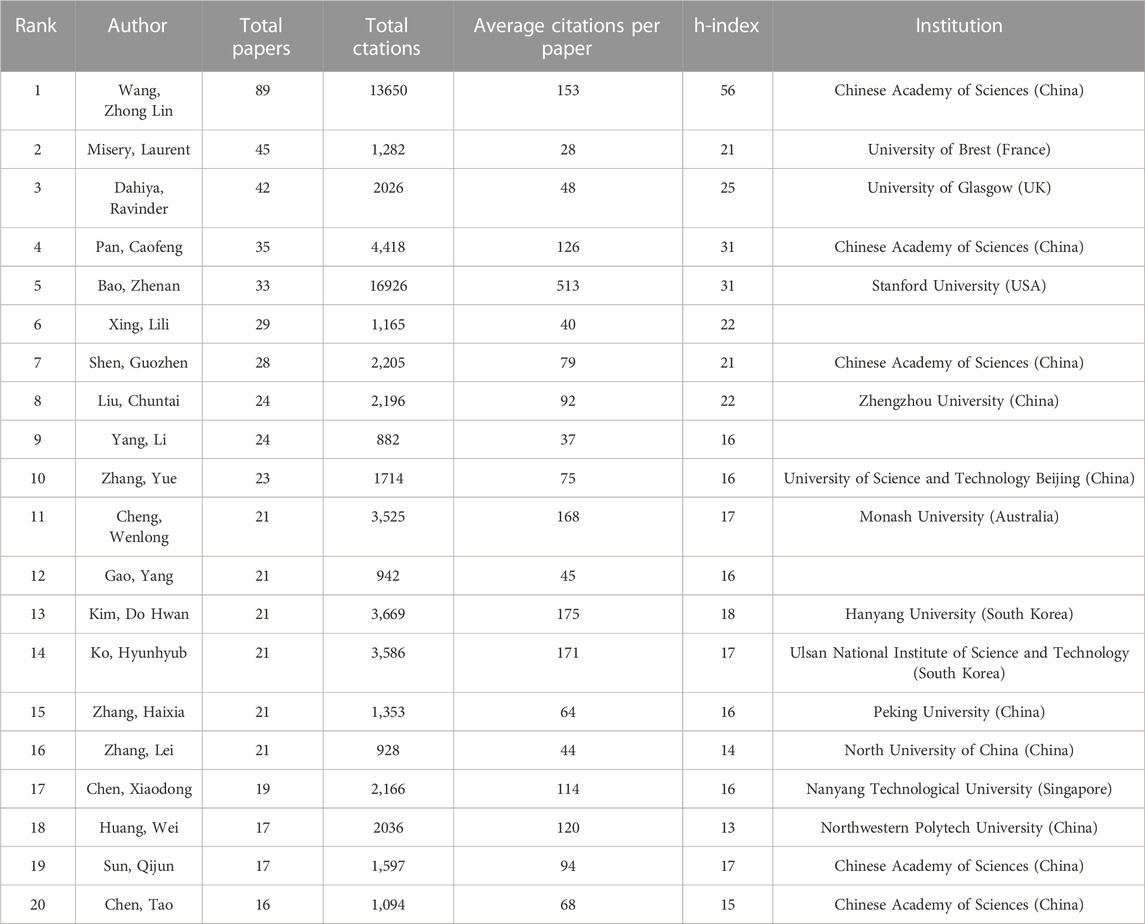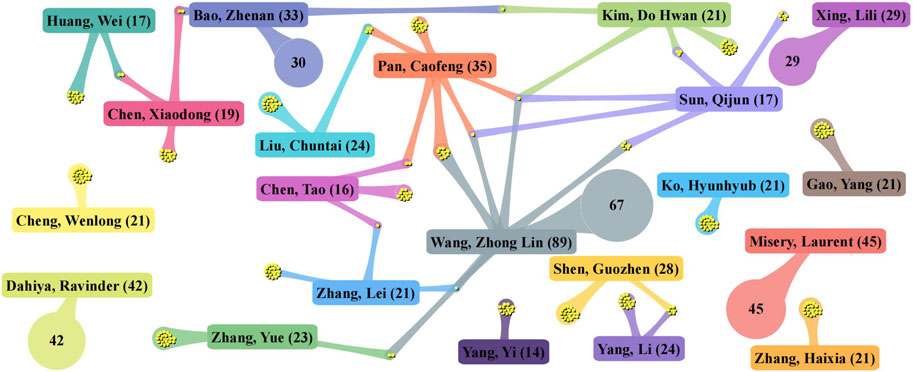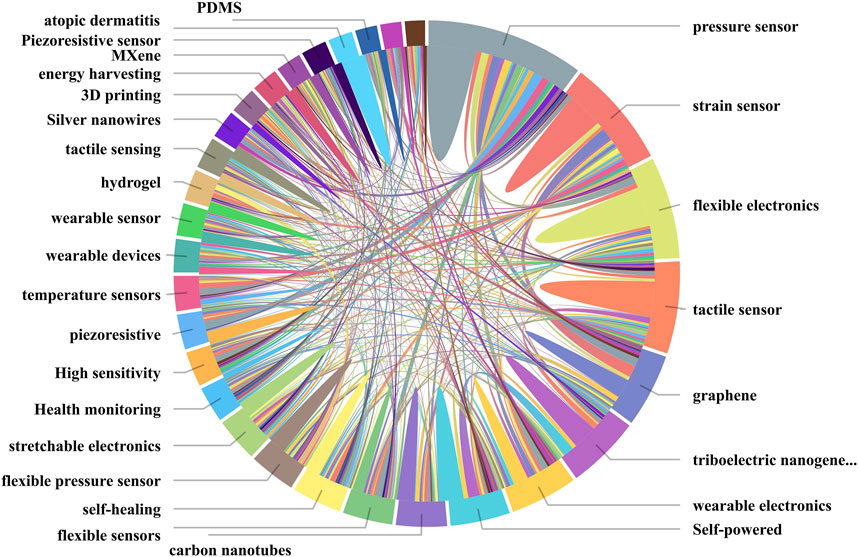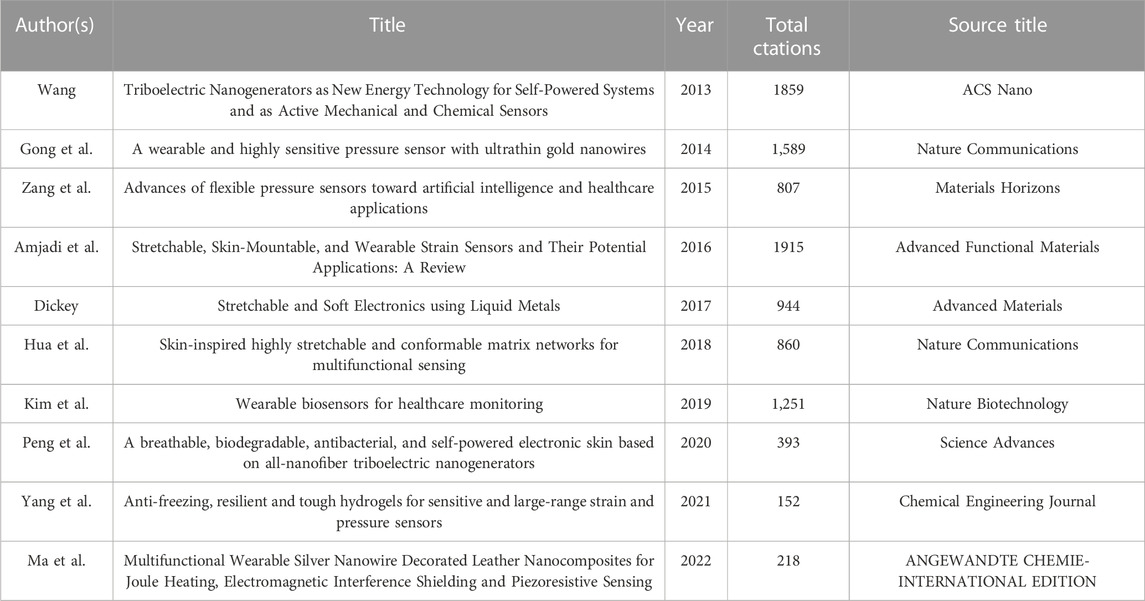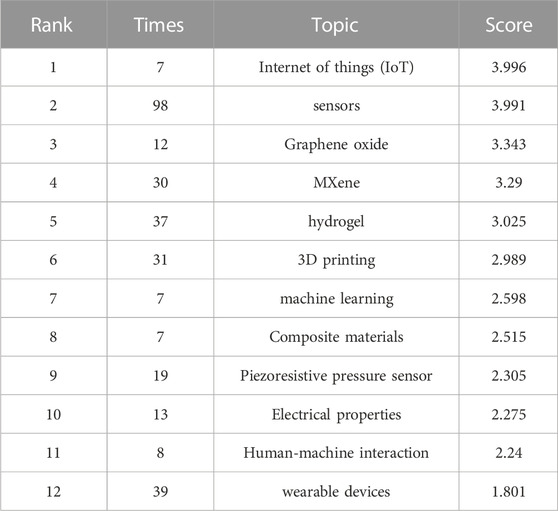- 1Zhejiang Sci-Tech University, Hangzhou, China
- 2Zhejiang University of Technology, Hangzhou, China
Background: E-skin (electronic skin) is an active research area in human-computer interaction and artificial intelligence.
Methods: A bibliometric analysis was performed to evaluate publications in the E-skin field between 2000 and 2021 based on the Web of Science (WoS) databases.
Results: A total of 4,954 documents were identified. A detailed overview of E-skin research was presented from aspects of productive countries/regions, institutions, journals, citations, highly cited papers, keywords, and emerging topics. With the emergence of new functional materials, structural design, 3D printing, and nanofabrication techniques, E-skin research has achieved dramatic progress after 2013. Scholars and institutions in China, the United States and South Korea are leading the way in E-skin research. Pressure sensor, strain sensor, and flexible electronics are the most focused directions at present and Internet of things is the most emerging topic.
Conclusion: E-skin research has achieved dramatic progress but there is still quite a challenging task in practical applications. Manufacturing process simplification, cost reduction, functional integration, energy supply, and biocompatibility are vital for the future development of E-skin.
1 Introduction
Electronic skin (E-skin), as a device that mimics functionalities and mechanical properties of natural skin, can find broad applications (Wang et al., 2020a). The skin is the largest organ of the human body and is a multi-functional sensor with high sensitivity for humans to perceive the external environment (Li et al., 2020a). It has significant meaning for human beings’ survival and development. With the help of E-skin, professionals can continuously monitor people’s health and sleep, and repair or even replace the injured skin of people with skin injuries or amputations (Lee et al., 2020). The core of E-skin is a flexible, stretchable and highly sensitive sensing array that boasts high-resolution and is composed of three main types of sensors: capacitive, resistive, and piezoelectric sensors (Lamport et al., 2020). The main technologies applied in E-skin research are wireless sensing, high-density flexible circuits (Shi et al., 2021), self-powered (Mao et al., 2020) and self-healing (Yeasmin et al., 2020) technologies, and the commonly used materials are hydrogels (Wang et al., 2020b), liquid metals (Silva et al., 2020), conductive polymers (Ahmed et al., 2020) and nanomaterials (Liu et al., 2020a).
By retrieving the Web of Science (WoS), Scopus, Google Scholar, and other literature databases, we consider that the research on E-skin originated in 1990 (Kales, 1990; Urruti and Wahl, 1990). E-skin related research before 1990s was devoted to the fabrication of sensors with tactile sensation, but it encountered bottlenecks in both device resolutions and material flexibility (Pfeiffer et al., 1969). After 1990s, the emergence of flexible materials improved the flexibility and stretchability of tactile sensors (Talat, 1991; Ko, 1996), which laid the foundation of E-skin research (Scott, 1997).
As the R&D process, E-skin has been performing an outstanding role in medical health and other fields since 2000. Researchers have designed kinds of strain sensors (Pu et al., 2018), pressure sensors (Chanchan et al., 2020), and temperature sensors (Harada et al., 2014) to simulate the skin’s transmission of physical parameters such as temperature and pressure (Zhao et al., 2021a). Research advances in electrophysiological signal sensors such as dry electrodes (Meijing et al., 2021), wet electrodes, and microneedles have improved the monitoring of cardiovascular diseases and neurological disorders (Wang et al., 2022a). With the help of several chemical sensors, E-skin can also monitor people’s health level based on the analysis of chemical substances such as sweat, saliva, and tears in real-time (Chao and Gang, 2021).
Many reviews focus on E-skin. Researchers have analyzed the mechanisms (Peng et al., 2021; Pyo et al., 2021; Nguyen and Lee, 2022), development, challenges, applications, and limitations of flexible tactile sensors (Al-Handarish et al., 2020; Oh et al., 2021), biosignal/health monitoring E-skin sensors, E-skin pressure sensors (Dos Santos et al., 2020; Claver and Zhao, 2021; Wang et al., 2022b), flexible temperature sensors (Liu et al., 2021a), flexible electronics in shape sensing application (Shaik and Rufus, 2021), E-skin sweat sensors (Tabasum et al., 2022), bio-inspired flexible electronics (Nie et al., 2022), metal and carbon nanomaterials flexible sensors (Liu et al., 2021b; Chen et al., 2021; Guo et al., 2021), MXene-based resistance pressure sensors (Vijayababu and Chintagumpala, 2022), and self-powered nanogenerators (Wu et al., 2020; Wang et al., 2021a). Reviews also cover microstructures of flexible and stretchable sensors (Yin, 2020; Qin et al., 2021), 3D printed sensors (Liu et al., 2021c), application of wearable sensors in firefighters’ protective clothing (Shakeriaski and Ghodrat, 2022), and several further topics (Yang Haizhen, 2021).
The increase in scientific research activities regarding E-skin has led to a rapid growth of research papers, and general research methods are inadequate to cover such massive literature, so it is necessary to adopt a new method to gain a full picture of the E-skin research. Bibliometrics is believed to be one such analytical method that has the ability to analyze massive literature at a macro and micro level (Kokol et al., 2021).
Unlike reviews that provide systematic summaries of specialized topics in E-skin, bibliometrics is known as a knowledge-generating system that can analyze a large amount of literature and provides a perspective of a field. The bibliometric approach that adding the dimension of time and space can present readers with the entire landscape of E-skin research from micro to macro level through analysis and visualization of massive literature.
Defined as “the application of mathematics and statistical methods to books and other media of communication” (Pritchard, 1969)., bibliometric analysis has become increasingly popular, It has been used to quantitatively analyze academic publications to evaluate the research trends in a large range of research fields such as Materials Science (Hu et al., 2021; Jing et al., 2023), Mechanical Engineering (Li et al., 2020b; Jumet et al., 2021), Energy Science (Liu et al., 2020b; Manan et al., 2022), Public Health (Ding et al., 2020; Wang et al., 2022c), Computer Science (Chen et al., 2019), Economics (Mirkouei et al., 2017), Design (Liu, 2022; Cao Ruzhong, 2023), and Ecology (Li et al., 2020c).
To all our knowledge, this paper is the first one to use bibliometric methods in specialized and systematic study of E-skin academic research. J. Yoon et al. studied the evolving trends in E-skin technology based patent bibliometrics in 2018 (Yoon et al., 2018), but it is patent-special and differs from our paper in terms of approach. To fill this research gap, this study uses the bibliometric method to 1) provide an overview of this field; 2) reveal key countries/regions, institutes, and authors and display their collaboration patterns; 3) identify major journals to offer support for researchers; 4) find research trends, primary themes, and emerging topics.
2 Methods
This analysis is based on the publications related to E-skin published between 2000 and 2021. Our work consists of four steps. Firstly, the bibliometric approach was adopted to investigate the papers of E-skin research. Next, data was cleaned and prepared for analysis. Then, the scientific map method was used to analyze the finally selected samples. Finally, our findings were discussed in a qualitative way. Figure 1 shows the workflow used in this work.
After referring to relevant literature and after repeated trials and discussions, we settled on the retrieval formula of “E-skin*" or “electronic skin*" or “smart skin*" or Eskin or “sensitive skin*". Papers were collected from Web of Science (WoS) with the defined retrieval formula. Our retrieval was limited to the most related bibliographic source Science Citation Index-Expanded (SCI-E). The search date was 13 May 2023 and the retrieved field was restricted to “topic” (the title, abstract, author keywords, and keywords plus of a paper).
For the 4,954 papers retrieved, the following steps were taken: data de-duplication; removal of literature not actually published between 2000 and 2022; removal of literature other than articles and reviews; manual screening to exclude other irrelevant literature. We excluded literature predating 2000 because of the low yield of papers and the relatively poor value of quantitative studies. As a result, 4,334 papers were retained for further analysis, including 3,812 articles and 522 reviews.
We used Derwent Data Analyzer 10 (DDA10) as the data cleaning and analytical tool. Like VOSviewer, CiteSpace, and Sci2, DDA is a data-mining platform that converts patent data, scientific literature and business intelligence into visualized, actionable insight (Qiu et al., 2017). As a tool under Clarivate, DDA can seamlessly interface with the WoS database and perform multidimensional cleaning and visualization of WoS data.
The data cleaning in this paper was achieved by a combination of computerized and manual cleaning. The cleaning of author, institution, country/region, and keyword data was done using the DDA built-in narrative table. The distinction of authors with the same name was achieved by associating author names with information such as institution and ORCID. The papers retrieved were organized and visualized into tables and DDA charts. Tables were applied to show the output, collaboration and influence of countries/regions, institutions, journals, and authors, as well as highly cited papers and emerging topics; a line chart plotted with Excel was used to illustrate the publication trend; a circle chart created with DDA was employed to explain the collaborative relationships among countries/regions, pie maps drawn with DDA were used to demonstrate the numerical relationships and co-occurrence between institutions and keywords; a bubble chart was adopted to show more intuitively the development trends of journals and a cluster map was used to display collaboration of authors with DDA.
3 Results
The 4,334 papers were published in 897 sources. A total of 17,615 authors from 79 countries/regions and 3,048 institutions contributed to the research of E-skin. An average citation of 52 per paper and a total citation of 227,560 make the 4,334 published papers relevant in the scientific community. E-skin research was involved in 155 WoS disciplines, with Multidisciplinary Materials Science, Nanoscience and Nanotechnology, Applied Physics, Physical Chemistry, and Multidisciplinary Chemistry among the disciplines having a high number of papers. A total of 219 funds supported the publication of these papers, with the National Natural Science Foundation of China (NSFC) being the major one. Among the 4,334 papers, there are 282 highly cited papers.
3.1 Trends of publishing
Figure 2 shows the annual analysis of publication trends. Research outputs of E-skin were 17 in 2000, and the number grew slowly in subsequent years. Until 2013, the yearly publication was less than 50 papers. Since 2013, with the rise of emerging forces such as China and South Korea, E-skin research has been witnessing a booming time. The number of E-skin research papers started to grow rapidly, with an annual rise of over 600 in recent years. The year 2022 was the most productive year, with 793 papers being published.
China, the USA, and South Korea are the top 3 most productive countries. The first E-skin research paper from Chinese scholars was published in 2001, and they started to demonstrate their investigative capacity and soon became a major force in E-skin research since 2015. The USA is considered the birthplace of E-skin research and has been the leader of international E-skin research for a long time. In recent years, the number of E-skin research papers published by American scholars has fallen behind that of Chinese scholars, but their international influence is still significant. Similar to Chinese scholars, South Korean scholars entered the international arena of E-skin research just a decade ago, but they have rapidly become a major player in this field.
3.2 Production and collaborations of countries/regions
Publications on E-skin between 2000 and 2022 come from 79 countries/regions. As shown in Table 1, China was the most prolific country for E-skin research papers, yielding half of the global paper output (n = 2,321, 53.55%). The three countries with the highest output of E-skin papers, China, the USA, and South Korea, published 3,262 journal articles and reviews, accounting for 75.26% of the global total. The remaining top 20 most productive countries were mostly located in Asia and Europe. Here, indicators such as h-index and Average Citations per Paper (ACPP) are introduced to measure the scientific research level of a country/institution/author. Some indicators can be explained as follows: Total Citations refers to the total number of citations. ACPP is calculated as Total Citations divided by Total Papers. International collaboration rate refers to the percent of international collaboration papers. The h-index is defined as the given country/institution/author has published h papers that have each been cited at least h times.
Austria holds the highest average citations of per paper (ACPP = 123), followed by Japan (ACPP = 99) and the USA (ACPP = 92). China (h-index = 152), the USA (h-index = 128) and South Korea (h-index = 90) are the three countries/regions with the highest h-index. China has the most international collaborative papers, but the three countries/regions with the highest percentage of international collaborations are Canada, Spain, and Singapore. It is worth to be concerned that apart from China and South Korea, the numbers of papers from Asian countries/regions such as Singapore, India and Taiwan, China are also growing rapidly.
Figure 3 displays country/region collaborations in E-skin research. Each point in the figure represents a country/region, and the size of the point indicates the output of papers and the thickness of the lines between points suggests the intenseness of cooperation between countries/regions. From the aesthetic angle, the figure excludes those low frequency collaborations (linked records <5). The highest frequency of collaboration occurs between China and the USA, followed by the USA and South Korea, China and Singapore, and China and Canada.
Chinese scholars are leading the world in E-skin research output, but have not yet collaborated tightly with European countries such as Switzerland and the Netherlands. The international center of E-skin research collaboration is the USA, and almost all countries/regions of E-skin research have the participation of American scholars. China and the USA are the two countries that work together most intensively. Unlike China, the USA, and European countries/regions, some Asian countries/regions, such as India and Taiwan, China, have no close collaborations with the top 20 most productive countries/regions.
3.3 Contribution and collaborations of leading institutions
A total of 3,048 institutions have participated in the study of E-skin. The top 20 most productive institutions are shown in Table 2. They contribute around 1/3 of the world’s E-skin research (n = 1,367, 31.05%). Among them, 15 are from China, two each from Singapore and South Korea, and one from the USA.
The Chinese Academy of Sciences is not only the most published institution, but also has the highest citation frequency and h-index. The University of Chinese Academy of Sciences (UCAS), Tsinghua University, and the Georgia Institute of Technology are next to UCAS in terms of numbers of papers, citation frequency and h-index. They are also the three institutions with the highest collaboration rate, with over 90% papers being the result of collaboration with other institutions, except for Tsinghua University. In terms of ACPP, the Georgia Institute of Technology is far ahead of the other institutions (ACPP = 122), followed closely by Tsinghua University (ACPP = 93). All the 206 papers from UCAS are the product of multiple institutional collaborations. The Chinese Academy of Sciences, the Georgia Institute of Technology, the National University of Singapore, and Seoul National University ranked from second to fifth on the collaboration lists.
Figure 4 illustrates the concrete collaborations among the top 20 institutions in E-skin research. In the smart pie chart, countries are represented by various colored circles. The larger the circle is, the higher volume of papers, and the connectivity strength between different colored circles represents the collaboration frequency between institutions.
It can be seen that the most productive institutions have more collaborations than other institutions. The Chinese Academy of Sciences, the Chinese Academy of Sciences University, Tsinghua University, and the Georgia Institute of Technology are the main central nodes of the E-skin research collaboration network. Strong collaborative relationships have been established among institutions from China, and close ties have been maintained between the Georgia Institute of Technology and those Chinese institutions. The most important partners of Tsinghua University are the Chinese Academy of Sciences and Georgia Tech. Peking University’s main collaborating institutions are the Chinese Academy of Sciences, the University of Chinese Academy of Sciences, and Tsinghua University. Some institutions, such as the University of Glasgow and Yonsei University, do not have many papers published in collaboration with major institutions, with more papers being published in collaboration with institutions outside of Figure 4. It is notable that collaborations on E-skin research are mainly between institutions from the same country, and that the level of collaboration between institutions from different countries needs to be improved.
3.4 Contributions of leading journals
Awareness of journals in the field facilitates the communication and sharing of scholarship among researchers. The 4,334 papers were published in 897 journals, with 546 journals publishing only one paper. In Table 3, the top 20 most productive journals are reported. The top 20 journals have published 1,743 papers which represent 40.22% of the papers in this study. ACS Applied Materials and Interfaces, Advanced Functional Materials, and Advanced Materials are the three most productive published journals for E-skin research papers over the past 20 years. In terms of citations, Advanced Materials has published 160 papers that have been cited 30,968 times, making itself the journal with the highest total citations and average citations per paper. Of the 20 journals, eight are from Wiley Publishing Group, three each from RSC and Elsevier, while IOP, MDPI and other publishing groups also have journals on the list.
The trend for the number of E-skin papers published by these 20 journals is shown in the bubble chart of Figure 5. The numbers contained within the bubbles represent the publications of the journal that year, and the larger the bubble, the more the papers.
As shown in Figure 5, the development of Science and Technology journals and scientific research is mutually reinforcing. Before 2013, only a few journals such asIEEE Sensors Journal and Sensors and Actuators A-Physical published papers on E-skin research. Subsequently, journals such as ACS Applied Materials and Interfaces and Advanced Functional Materials became the main forum for E-skin research and led to the flourishing of E-skin research. Other journals that have grown rapidly in recent years include Chemical Engineering Journal, Sensors, ACS nano, etc.
3.5 Contribution and collaboration of leading authors
The top 20 most productive authors are shown in Table 4, and they are mostly from China (10 of 20). To more clearly reveal the contributions and collaborations of the leading authors, we screened the authors and only kept one representative for those researchers from a stable team of the same institution.
Five of the 20 high-producing authors are from the Chinese Academy of Sciences. Z.L. Wang from the Chinese Academy of Sciences, L. Misery from the University of Brest, and R. Dahiya from the University of Glasgow are the three researchers producing the most E-skin papers. Leading the table of total citations are Z.A. Bao, Z.L. Wang and C.F. Pan. Researchers from the USA, Japan and South Korea have the highest average citations per paper records (Z.A. Bao, D. Kim, and H. Ko). Topping the h-index list is Z.L. Wang (from the Chinese Academy of Sciences), followed by Z.A. Bao and C.F. Pan.
Figure 6 reveals the collaborative relationship between the leading authors of the E-skin study. In the collaborative network, the number following the author’s name is his or her number of publications, and the number of yellow dots in the circles indicates the count of collaborated papers. To enhance the presentation quality of the figure, collaborations with a low frequency are hidden.
The intensity of collaboration among the leading scholars of E-skin research is the modest. Scholars such as Z.L. Wang, G.Z. Shen, and C.F. Pan who are from the Chinese Academy of Sciences and Z.A. BAO from Stanford University are at the center of the collaborative network and lead the trend of E-skin research. Other collaborative teams, such as W. Huang and X.D. Chen, G.Z. Shen and Y. Li, maintain favorable collaborative relationships with them. Some of the authors, including L. Misery, R. Dahiya, W.L. Cheng, H.X. Zhang, and L.L. Xing, have primary collaborators from teams other than leading authors listed in this paper.
3.6 An analysis of yearly most cited papers
The frequent citations of a paper are backed by the popularity of that topic under study. Among the 4,334 papers, there are 282 Essential Science Indicators (ESI) highly cited papers, and Table 5 shows the yearly most cited papers. ESI highly cited papers selected from the most recent 10 years of ESI data reflect the top 1% of papers by field and publication year. Since the statistics of ESI highly cited papers are limited to the last 10 years, the presentation starts from 2013.
The most highly regarded study in 2013 was a triboelectric nanogenerator that can be applied to harvest mechanical energy such as human motion, walking, and vibration and be used as a self-powered sensor (Wang, 2013). The most cited paper in 2014 was about an embedded-3D printing method for fabricating strain sensors within highly conformal and extensible elastomeric matrices (Muth et al., 2014). The top papers of 2015 and 2016 were both reviews of focal issues in E-skin research, including a review on the fundamentals of flexible pressure sensors (Zang et al., 2015), and a review on potential and challenges for train sensing performances of flexible, skin-mountable, and wearable strain sensors that were hot in 2016 (Amjadi et al., 2016). An emerging electronics class for soft and stretchable electronics, and liquid metals based on gallium, has been cited 719 times within 6 years (Dickey, 2017). Top research in 2018 was a skin-inspired highly stretchable and conformable matrix network (SCMN), which can expand the E-skin sensing functionality including temperature, humidity, light, pressure, proximity, etc (Hua et al., 2018). Wearable biosensor, especial for electrochemical and optical biosensors providing dynamic, noninvasive measurements with continuous, real-time physiological information, was the buzzword for 2019 (Kim et al., 2019). In 2020, comfortability and environmental friendliness of E-skin became a priority research area, and a paper on a triboelectric nanogenerators with micro-to-nano hierarchical porous structure was referred by 204 times (Peng et al., 2020). The researchers’ latest concentration is on the process of wearable hydrogel sensors for E-skin with high sensitivity and large-range detection capacity (Yang et al., 2021a). A study on multifunctional wearable silver nanowire decorated leather nanocomposites for piezoresistive sensing (Ma et al., 2022) if currently the most popular of E-skin papers published in 2022 (Ma et al., 2022).
Besides the above-mentioned ESI highly cited papers, there are some papers that are not ESI highly cited papers but have high citation frequency. For instance, T. Someya’s paper on flexible pressure sensor matrix (Someya et al., 2004) published in 2004 has been cited 1,541 times to date, and G. Schwartz’s paper named “Pursuing prosthetic electronic skin” (Chortos et al., 2016) and a paper on slexible and stretchable physical sensor Integrated platforms by T.Q. Trung et al. (Trung and Lee, 2016) also been cited over 1,000 times since 2016. S. Mannsfeld’s paper “Highly sensitive flexible pressure sensors with microstructured rubber dielectric layers” (Mannsfeld et al., 2010) published in 2010 is the most cited paper on E-skin research at present, with 2,007 citations.
3.7 An analysis of emerging topics
To help researchers identify emerging research areas worthy of attention in the field, we calculated emerging topics in E-skin research. The DDA emerging trends indicator tracks the evolution of subject terms based on four key factors: novelty, persistence, degree of community, and growth, demonstrating a temporal sequence of subject evolution with some predictive power. The emerging trends indicator is calculated using words or phrases mined from the titles and abstracts of papers from the past 10 years to detect emerging subject terms based on a benchmark of the previous 3 years (Kwon et al., 2020). (See Table 6) Mature technology areas such as composite materials and piezoresistive pressure sensor tend to score lower than emerging areas because improvements are usually incremental rather than groundbreaking (Li et al., 2021a).
Among these topics, the pressure sensor is the major area of E-skin research, and the rising research fervor in piezoresistive pressure sensor has continued since 2016. Researchers have explored the sensing mechanism, selection of sensing materials, structural design and their advanced application of piezoresistive pressure sensor extensively (Liao et al., 2019; Li et al., 2020d; Li et al., 2021b). 3D printing has the advantages of low cost and efficiency over lithography and transfer printing, and research on manufacturing flexible strain sensors through 3D printing technologies such as digital light processing (DLP) (Yin et al., 2021a), fused deposition molding (FDM) (Farooq et al., 2021), and direct ink writing (DIW) (Yang et al., 2021b) has been under academic scrutiny since 2017 (Liu et al., 2018). Hydrogel has unique features such as flexibility and biocompatibility that make it an ideal material for electronic skin (Zhang et al., 2019a), and since 2017, researchers have carried out a series of works to solve the problem of drying and freezing in practical applications of hydrogel (Zhang et al., 2019b; Zheng et al., 2020). As an emerging family of metal carbides/nitrides, graphene oxide, especially MXene, has been booming since 2019, and MXene-based sensors with various functions are being used widely (Chen et al., 2020; Wang et al., 2021b; Liu et al., 2022a). Transparent and scalable human-machine interaction is also one of the trends in E-skin research for recent years. Researchers have conducted a deep investigation on how to achieve long-term, stable and accurate human information monitoring, recording and transmission, and provide highly reliable and composite E-skin (Yin et al., 2021b; Wang et al., 2021c).
It is worth noting that with the widespread of 5G network, E-skin plays an increasingly critical role in the technological revolution (Liu et al., 2017). It has become the primary content of modern information application scenarios such as smart city, wireless network and Internet of things, and is advancing into the era of artificial intelligence and Internet of things (Liu et al., 2021d). Since 2020, 5G network has become the most promising research direction of E-skin (Shi et al., 2020; Zhao et al., 2021b; Song et al., 2022).
4 Discussion
4.1 E-skin: from science fiction to reality
The idea of E-skin has arisen in many science fiction books and science fiction movies since the middle 20th century or even earlier decades. In the road opened by science fiction, the advancement of E-skin has experienced a process of gradual improvement from scratch, gradually achieving characteristics such as sensing, bending, self-healing, sensitivity, precision, etc (Zhang et al., 2022).
An increase in the yearly output of countries/regions, institutions, and journals indicate that with breakthroughs in new material technologies, research on E-skin has entered a period of rapid development after 2013. China has become the leader of E-skin research. Institutions such as the Chinese Academy of Sciences are beginning to emerge in the field. Journals such as ACS Applied Materials and Interfaces have become major publishing platforms in the field.
China, and institutions and scholars from China, have replaced the USA as the most productive force of E-skin research with the highest h-index. Similar examples are South Korea and Singapore. But we can find from other viewpoints such as average citations per paper and the percentage of international collaborations that American and European countries, represented by the USA, are still a strong force in E-skin research. Another supporting material is the international collaboration rate of publications. The international collaboration rate of papers from countries such as China and South Korea is only half of that between the USA and the UK. Emerging countries still have a long way to go to fully keep up with American and European developed countries in E-skin research.
Thanks to the emergence of new functional materials, structural design, 3D printing technologies, artificial intelligence and nanofabrication techniques, E-skin research has achieved dramatic progress in the last two decades. Novel materials have been developed and applied to the preparation of E-skin, include: graphene, carbon nanotubes, polydimethylsiloxane, metallic nanoparticles, conductive polymers, metallic liquids and ionic liquids, and hydrogels. Some properties of E-skin have approached or even surpassed the perception ability of human skin. E-skin improvements in self-powered capability (Zhang et al., 2019c), device comfort (Zhao et al., 2022), sensitivity (Lin et al., 2021), self-healing capability (Khatib et al., 2020), and integration (Wen et al., 2021) are as represented in the bibliometric results.
4.2 Challenges
However, the research of E-skin is still quite a challenging task in practical applications. It is necessary to increase the efforts of cross-disciplinary research, establish closer collaboration of industry, academia and research, and continuously overcome the performance, cost and process problems that limit the popularity of E-skin. The fields of medicine and health are the main areas of E-skin applications, but from the distribution of papers in terms of disciplines and topics, the concerns of researchers are currently still on R&D of new material. At present, E-skin research is still located in the fields of materials science, physics, and chemistry, and the number of papers from medical and health-related fields such as Surgery, Public Health, and Immunology is small. As seen in the literature analysis, issues such as insufficient capacity of self-powered device (Ferrer et al., 2017), weak sensor immunity, inability to large area self-healing (Guo et al., 2022), shortage of multi-sensor and multi-functional integration capabilities (Luo et al., 2021), and poor customizability (Yao et al., 2021) still perplex practitioners of E-skin research. Latest research results have laid the groundwork for investigating E-skins over larger areas (Liu et al., 2022b) and with ultra low hysteresis (Shen et al., 2022), and allowing E-skins to operate in harsh temperature environments (Hao et al., 2022). The simplification of the manufacturing process, the reduction of production costs, the enhancement of integration capabilities, the improvement of energy supply, and the realization of environmental protection is the vital directions of the future development of E-skin.
4.3 Prospects
Highly sensitive E-skin usually involves complex manufacturing processes and techniques which would make the cost of manufacturing E-skin rather high, thus limiting the possibility of mass production of E-skin. Traditional E-skin manufacturing processes require specialized clean rooms and process steps dedicated to assembling circuits onto elastic substrates. Researchers are constantly working on the micromachining procedures that are essential for miniaturization (Ma et al., 2023). The advent of 3D printing offers the possibility of simplifying the E-skin manufacturing process (Cao et al., 2022), its unique structure and arbitrary shape printing capability can endow E-skin sensors with excellent flexibility and functionality (Pei et al., 2023), but still faces challenges in terms of scaling up production and reducing production costs. In addition, Extended Reality (XR) technologies, including VR, AR, and MR are creating a new virtual space where E-skin will be a useful agent to connect physical reality with virtual space, and the demand for XR applications will further drive the technological advancement of E-skin.
Most of the current E-skins are unimodal, with only primary signal processing capability, and require external devices for analysis and control. In order to improve the performance of E-skin, it is necessary to integrate temperature, pressure, humidity, and light sensors into one E-skin platform to realize multi-functional E-skin with properties of stretchability, self-healing, and biocompatibility at the same time. Researchers have made some progress in miniaturization of E-skin, parallel signal analysis, miniature power supply, integral communication, incorporation of machine learning and artificial intelligence (Wang et al., 2022d). Multi-stimulation sensors using multifunctional hydrogels have been reported more recently, and researchers have developed multi-responsive nanostructured ion-conductive hydrogels dedicated to achieving a combination of transparency, electrical conductivity, hyperstretchability, toughness, fatigue resistance, and adhesive capabilities (Zhang et al., 2023). However, multifunctional E-skin inevitably leads to a complex preparation process and high manufacturing cost, and requires a balance between performance and cost.
As a wearable electronic device, the power or energy issue has always been one of the most critical matters in E-skin research. Too large power supply devices or too complicated power supply circuits will affect the performance of E-skin. Developing new low-power or self-powered E-skin is a feasible way. Energy harvesting methods with good application prospects include triboelectric nanogenerators, thermoelectric generators, and flexible perovskite cells (Peng et al., 2022). Among them, triboelectric nanogenerators are considered as the most promising way for energy harvesting and self-powered sensing due to their excellent performance in the conversion of mechanical energy into electrical energy (Shi et al., 2023). Another hot topic is thermoelectric materials. Emerging thermoelectric materials can convert a heat flux into an electric current, and Researchers have assembled flexible thermoelectric devices from various types of thermoelectric materials (Saha et al., 2023). Technologies such as solar power, supercapacitors, and kinetic energy conversion devices are expected to be utilized to achieve self-powered of E-skin. Researchers have designed flexible piezoelectric self-powered mechanical sensors to collect mechanical energy generated by human motion (Kar et al., 2023). If these small power supply devices can meet the demand for stability, reliability, and actual output power, E-skin will become a commonly adopted wearable device.
With human society entering the low-carbon era, green features such as biodegradability, self-healing and biocompatibility will be critical for the future application of E-skin. Researchers have turned to a variety of natural and synthetic polymer-based biodegradable materials (Liu et al., 2022c) and are working to reduce the use of toxic and hazardous solvents in the manufacturing process. A more eco-friendly approach to E-skin manufacturing appears to be desirable (Xu et al., 2023). The idea of reusing or degrading E-skin is becoming a reality (Zhao et al., 2023). Some E-skins that exhibit superior biocompatibility and non-polluting properties such as hydrogel E-skin have become candidates for the next-generation of biodegradable E-skin. Targeting the poor mechanical properties and robustness typically exhibited by hydrogel-based strain sensors, researchers have worked on the development of more robust, fast-responding, degradable, and recyclable MXene hydrogels to reduce environmental pollution (Liu et al., 2023).
4.4 Limitations
Although it is a comprehensive study, it suffers from some limitations. Our database selection and the retrieval formula used will result in some papers not being included in the data set. Some high-quality papers may be missed in the retrieval process because they are not included in the SCI-E database or are published in languages other than English. The missing information such as keywords of some papers will in turn lead to the analysis not covering all papers.
5 Conclusion
This study aims to describe a bibliometric analysis of E-skin research. A detailed overview of E-skin research was presented from aspects of productive countries/regions, institutions, journals, citations, highly cited papers, keywords, and emerging topics. It is useful for newcomers to quickly get the full picture of E-skin research. It also aids professionals in their identification of future topics and choices of partners. Additionally, this work can help policymakers promote the policy of E-skin related industries.
Data availability statement
The original contributions presented in the study are included in the article/Supplementary Material, further inquiries can be directed to the corresponding author.
Author contributions
Conceptualization, SX; methodology, YJ; software, JC; data curation, XY; writing—original draft preparation, SX; writing—review and editing, YJ and XY; visualization, JC; supervision, YJ. All authors contributed to the article and approved the submitted version.
Conflict of interest
The authors declare that the research was conducted in the absence of any commercial or financial relationships that could be construed as a potential conflict of interest.
Publisher’s note
All claims expressed in this article are solely those of the authors and do not necessarily represent those of their affiliated organizations, or those of the publisher, the editors and the reviewers. Any product that may be evaluated in this article, or claim that may be made by its manufacturer, is not guaranteed or endorsed by the publisher.
References
Ahmed, A., Guan, Y. S., Hassan, I., Ling, C., Li, Z., Mosa, I., et al. (2020). Multifunctional smart electronic skin fabricated from two-dimensional like polymer film. Nano Energy 75 (42), 105044. doi:10.1016/j.nanoen.2020.105044
Al-Handarish, Y., Omisore, O. M., Igbe, T., Han, S., Li, H., Du, W., et al. (2020). A survey of tactile-sensing systems and their applications in biomedical engineering. Adv. Mater Sci. Eng. 2020, 1–17. doi:10.1155/2020/4047937
Amjadi, M., Kyung, K. U., Park, I., and Sitti, M. (2016). Stretchable, skin-mountable, and wearable strain sensors and their potential applications: A review. Adv. Funct. Mater 26 (11), 1678–1698. doi:10.1002/adfm.201504755
Cao, K. L., Wu, M., Bai, J. B., Wen, Z., Zhang, J., Wang, T., et al. (2022). Beyond skin pressure sensing: 3D printed laminated graphene pressure sensing material combines extremely low detection limits with wide detection range. Adv. Funct. Mater 32 (28), 2202360. doi:10.1002/adfm.202202360
Cao Ruzhong, Z. Y. W. D. (2023). Visual analysis of cultural and creative industry policy research based on bibliometrics. J. Silk 59 (3), 76–84.
Chanchan, L., Xuhong, M., Ailan, W., and Xiaoxue, H. (2020). Design and verification of arm monitoring sensor. J. Silk 57 (2), 108–113.
Chao, M., and Gang, Z. (2021). Recent progress in electronic skin: Materials, functions and applications. J. Univ. Sci. Technol. China 51 (10), 725–746.
Chen, M. M., Hu, X. Y., Li, K., Sun, J., Liu, Z., An, B., et al. (2020). Self-assembly of dendritic-lamellar MXene/Carbon nanotube conductive films for wearable tactile sensors and artificial skin. Carbon 164, 111–120. doi:10.1016/j.carbon.2020.03.042
Chen, Y., Jin, Q., Fang, H., Lei, H., Hu, J., Wu, Y., et al. (2019). Analytic network process: Academic insights and perspectives analysis. J. Clean. Prod. 235, 1276–1294. doi:10.1016/j.jclepro.2019.07.016
Chen, Z. T., Zhao, D. N., Ma, R., Zhang, X., Rao, J., Yin, Y., et al. (2021). Flexible temperature sensors based on carbon nanomaterials. J. Mater Chem. B 9 (8), 1941–1964. doi:10.1039/d0tb02451a
Chortos, A., Liu, J., and Bao, Z. A. (2016). Pursuing prosthetic electronic skin. Nat. Mater 15 (9), 937–950. doi:10.1038/nmat4671
Claver, U. P., and Zhao, G. (2021). Recent progress in flexible pressure sensors based electronic skin. Adv. Eng. Mater. 23 (5), 2001187. doi:10.1002/adem.202001187
Dickey, M. D. (2017). Stretchable and soft electronics using liquid metals. Adv. Mater 29 (27), 1606425. doi:10.1002/adma.201606425
Ding, Y., Chen, D. W., Ding, X. F., Wang, G., Wan, Y., and Shen, Q. (2020). A bibliometric analysis of income and cardiovascular disease Status, Hotspots, Trends and Outlook. Medicine 99 (34), e21828. doi:10.1097/md.0000000000021828
Dos Santos, A., Fortunato, E., Martins, R., Aguas, H., and Igreja, R. (2020). Transduction mechanisms, micro-structuring techniques, and applications of electronic skin pressure sensors: A review of recent advances. Sensors-Basel. 20 (16), 4407. doi:10.3390/s20164407
Farooq, M. A., Salahuddin, A., Mushtaq, A., and Razzaq, M. (2021). A simplified finite difference method (SFDM) solution via tridiagonal matrix algorithm for MHD radiating nanofluid flow over a slippery sheet submerged in a permeable medium. Math. Probl. Eng. 2021, 2021–2117. doi:10.1155/2021/6628009
Ferrer, P. R., Mace, A., Thomas, S. N., and Jeon, J. W. (2017). Nanostructured porous graphene and its composites for energy storage applications. Nano Converg. 4, 29. doi:10.1186/s40580-017-0123-0
Guo, Q. Q., Qiu, X. Y., and Zhang, X. X. (2022). Recent advances in electronic skins with multiple-stimuli-responsive and self-healing abilities. Materials 15 (5), 1661. doi:10.3390/ma15051661
Guo, Y. J., Wei, X., Gao, S., Yue, W., Li, Y., and Shen, G. (2021). Recent advances in carbon material-based multifunctional sensors and their applications in electronic skin systems. Adv. Funct. Mater 31 (40), 2104288. doi:10.1002/adfm.202104288
Hao, S. W., Meng, L., Fu, Q. J., Xu, F., and Yang, J. (2022). Low-Temperature tolerance and conformal adhesion zwitterionic hydrogels as electronic skin for strain and temperature responsiveness. Chem. Eng. J. 431, 133782. doi:10.1016/j.cej.2021.133782
Harada, S., Kanao, K., Yamamoto, Y., Arie, T., Akita, S., and Takei, K. (2014). Fully printed flexible fingerprint-like three-Axis tactile and slip force and temperature sensors for artificial skin. Acs Nano 8 (12), 12851–12857. doi:10.1021/nn506293y
Hu, H., Liu, A., Wan, Y., and Jing, Y. (2021). Energy storage ceramics: A bibliometric review of literature. Materials 14 (13), 3605. doi:10.3390/ma14133605
Hua, Q. L., Sun, J. L., Liu, H. T., Bao, R., Yu, R., Zhai, J., et al. (2018). Skin-inspired highly stretchable and conformable matrix networks for multifunctional sensing. Nat. Commun. 9 (1), 244. doi:10.1038/s41467-017-02685-9
Jing, Y., Su, F., Yu, X., Fang, H., and Wan, Y. (2023). Advances in artificial muscles: A brief literature and patent review. Front. Bioeng. Biotechnol. 11, 1083857. doi:10.3389/fbioe.2023.1083857
Jumet, B., Bell, M. D., Sanchez, V., and Preston, D. J. (2021). A data-driven review of soft robotics. Adv. Intell. Syst. 4, 2100163. doi:10.1002/aisy.202100163
Kar, E., Bose, N., and Das, S. (2023). Submicron graphite platelet-incorporated PVDF composite: An efficient body motion-based energy harvester for flexible electronics. Carbon Lett. 33, 751–760. doi:10.1007/s42823-022-00457-0
Khatib, M., Zohar, O., Saliba, W., and Haick, H. (2020). A multifunctional electronic skin empowered with damage mapping and autonomic acceleration of self-healing in designated locations. Adv. Mater 32 (17), 2000246. doi:10.1002/adma.202000246
Kim, J., Campbell, A. S., de Avila, B., and Wang, J. (2019). Wearable biosensors for healthcare monitoring. Nat. Biotechnol. 37 (4), 389–406. doi:10.1038/s41587-019-0045-y
Ko, W. H. (1996). The future of sensor and actuator systems. Sens. Actuat A-Phys. 56 (1-2), 193–197. doi:10.1016/0924-4247(96)01288-5
Kokol, P., Blazun Vosner, H., and Zavrsnik, J. (2021). Application of bibliometrics in medicine: A historical bibliometrics analysis. Health Info Libr. J. 38 (2), 125–138. doi:10.1111/hir.12295
Kwon, S., Youtie, J., and Porter, A. L. (2020). Interdisciplinary knowledge combinations and emerging technological topics: Implications for reducing uncertainties in research evaluation. Res. Eval. 30, 127–140. doi:10.1093/reseval/rvaa029
Lamport, Z. A., Cavallari, M. R., Kam, K. A., McGinn, C. K., Yu, C., and Kymissis, I. (2020). Organic thin film transistors in mechanical sensors. Adv. Funct. Mater 30 (51), 202004700. doi:10.1002/adfm.202004700
Lee, G., Bae, G. Y., Son, J. H., Lee, S., Kim, S. W., Kim, D., et al. (2020). User-interactive thermotherapeutic electronic skin based on stretchable thermochromic strain sensor. Adv. Sci. 7 (17), 202001184. doi:10.1002/advs.202001184
Li, F. C., Kong, Z., Wu, J. H., Ji, X. Y., and Liang, J. J. (2021). Advances in flexible piezoresistive pressure sensor. Acta Phys. Sin. -Chinese edition-. 70 (10), 100703. doi:10.7498/aps.70.20210023
Li, L., Lu, J., Fang, H., Yin, Z., Wang, R., Wang, T., et al. (2020). Lattice Boltzmann method for fluid-thermal systems: Status, hotspots, trends and outlook. Ieee Access 8, 27649–27675. doi:10.1109/access.2020.2971546
Li, M., Porter, A. L., Suominen, A., Burmaoglu, S., and Carley, S. (2021). An exploratory perspective to measure the emergence degree for a specific technology based on the philosophy of swarm intelligence. Technol. Forecast Soc. 166 (1), 120621. doi:10.1016/j.techfore.2021.120621
Li, Q., Guo, X., and Zhang, L. (2020). Bibliometric analysis of water resource management. J. Coast. Res. 105 (1), 210–214. doi:10.2112/jcr-si105-044.1
Li, S., Zhang, Y., Wang, Y. L., Xia, K., Yin, Z., Wang, H., et al. (2020). Physical sensors for skin-inspired electronics. Infomat 2 (1), 184–211. doi:10.1002/inf2.12060
Li, W. D., Pu, J. H., Zhao, X., Jia, J., Ke, K., Bao, R. Y., et al. (2020). Scalable fabrication of flexible piezoresistive pressure sensors based on occluded microstructures for subtle pressure and force waveform detection. J. Mater Chem. C 8 (47), 16774–16783. doi:10.1039/d0tc03961f
Liao, Y. Z., Duan, F., Zhang, H. T., Lu, Y., Zeng, Z., Liu, M., et al. (2019). Ultrafast response of spray-on nanocomposite piezoresistive sensors to broadband ultrasound. Carbon 143, 743–751. doi:10.1016/j.carbon.2018.11.074
Lin, X. Z., Li, F., Bing, Y., Zhao, H. R., and Zhang, T. (2021). A flexible pressure sensor based on bimaterial conductivity-conversion mechanism. Ieee Electr. Device L 42 (12), 1857–1860. doi:10.1109/led.2021.3118062
Liu, C. Y., Huang, N. G., Xu, F., Tong, J., Chen, Z., Gui, X., et al. (2018). 3D printing technologies for flexible tactile sensors toward wearable electronics and electronic skin. Polymers-Basel. 10 (6), 629. doi:10.3390/polym10060629
Liu, D., Gao, Y., Song, Y., Zhu, H., Zhang, L., Xie, Y., et al. (2022). Highly sensitive multifunctional electronic skin based on nanocellulose/MXene composite films with good electromagnetic shielding biocompatible antibacterial properties. Biomacromolecules 23 (1), 182–195. doi:10.1021/acs.biomac.1c01203
Liu, F. Y., Deswal, S., Christou, A., Sandamirskaya, Y., Kaboli, M., and Dahiya, R. (2022). Neuro-inspired electronic skin for robots. Sci. ROBOTICS 7 (67), eabl7344. doi:10.1126/scirobotics.abl7344
Liu, H. D., Zhang, H. J., Han, W. Q., Lin, H., Li, R., Zhu, J., et al. (2021). 3D printed flexible strain sensors: From printing to devices and signals. Adv. Mater 33 (8), 202004782. doi:10.1002/adma.202004782
Liu, L., Guo, X., Liu, W., and Lee, C. (2021). Recent progress in the energy harvesting technology-from self-powered sensors to self-sustained IoT, and new applications. Nanomaterials 11 (11), 2975. doi:10.3390/nano11112975
Liu, M. Y., Hang, C. Z., Zhao, X. F., Zhu, L. Y., Ma, R. G., Wang, J. C., et al. (2021). Advance on flexible pressure sensors based on metal and carbonaceous nanomaterial. Nano Energy 87, 106181. doi:10.1016/j.nanoen.2021.106181
Liu, R. P., He, L., Cao, M. J., Sun, Z., Zhu, R., and Li, Y. (2021). Flexible temperature sensors. Front. Chem. 9, 539678. doi:10.3389/fchem.2021.539678
Liu, R. Y., Lai, Y., Li, S. X., Wu, F., Shao, J., Liu, D., et al. (2022). Ultrathin, transparent, and robust self-healing electronic skins for tactile and non-contact sensing. Nano Energy 95, 107056. doi:10.1016/j.nanoen.2022.107056
Liu, R. Z., Xu, K., and Zhang, Y. (2020). Nanomaterial-based wearable pressure sensors: A minireview. Instrum. Sci. Technol. 48 (4), 459–479. doi:10.1080/10739149.2020.1737935
Liu, T. F., Hu, H. L., Ding, X. F., Yuan, H., Jin, C., Nai, J., et al. (2020). 12 years roadmap of the sulfur cathode for lithium sulfur batteries (2009-2020). Energy Storage Mater 30, 346–366. doi:10.1016/j.ensm.2020.05.023
Liu, X., Tang, C., Du, X. H., Xiong, S., Xi, S., Liu, Y., et al. (2017). A highly sensitive graphene woven fabric strain sensor for wearable wireless musical instruments. Mater Horiz. 4 (3), 477–486. doi:10.1039/c7mh00104e
Liu, Y. (2022). Visualization analysis of literature regarding research advances on Bejjing opera costumes[J].Journal of Silk 59 (7), 71–78. doi:10.3969/j.issn.1001-7003.2022.07.010
Liu, Y. Q., Lv, X. X., Song, Y., Ao, Q., Yuan, B., Huang, T., et al. (2023). Sustainable and tough MXene hydrogel based on interlocked structure for multifunctional sensing. Acs Sustain Chem. Eng. 11 (10), 4177–4186. doi:10.1021/acssuschemeng.2c06939
Luo, S., Zhou, X., Tang, X. Y., Li, J., Wei, D., Tai, G., et al. (2021). Microconformal electrode-dielectric integration for flexible ultrasensitive robotic tactile sensing. Nano Energy 80, 105580. doi:10.1016/j.nanoen.2020.105580
Ma, J. C., Quhe, R. G., Zhang, W. L., Yan, Y., Tang, H., Qu, Z., et al. (2023). Zn microbatteries explore ways for integrations in intelligent systems. Small 2023, 2300230. doi:10.1002/smll.202300230
Ma, Z., Xiang, X., Shao, L., Zhang, Y., and Gu, J. (2022). Multifunctional wearable silver nanowire decorated leather nanocomposites for joule heating, electromagnetic interference shielding and piezoresistive sensing. Angew. Chem. Int. Ed. 61 (15), e202200705. doi:10.1002/anie.202200705
Manan, A., Rehman, M. U., Faisal, S., Ullah, A., Ghazi, Z. A., Khan, M. A., et al. (2022). Simultaneously achievement of high recoverable energy density and efficiency in sodium niobate-based ceramics. J. Mater Sci-Mater El. 33, 22208.
Mannsfeld, S., Tee, B., Stoltenberg, R. M., Chen, C. V. H. H., Barman, S., Muir, B. V. O., et al. (2010). Highly sensitive flexible pressure sensors with microstructured rubber dielectric layers. Nat. Mater 9 (10), 859–864. doi:10.1038/nmat2834
Mao, Y. P., Yue, W., Zhao, T. M., Shen, M., Liu, B., and Chen, S. (2020). A self-powered biosensor for monitoring maximal lactate steady state in sport training. Biosensors 10 (7), 75. doi:10.3390/bios10070075
Meijing, M., Liyan, L., Xinhua, G., and Hao, L. (2021). Research progress of flexible biopotential dry electrodes based on new materials. Adv. Text. Technol. 29 (04), 18–26.
Mirkouei, A., Haapala, K. R., Sessions, J., and Murthy, G. S. (2017). A review and future directions in techno-economic modeling and optimization of upstream forest biomass to bio-oil supply chains. Renew. Sust. Energ Rev. 67, 15–35. doi:10.1016/j.rser.2016.08.053
Muth, J. T., Vogt, D. M., Truby, R. L., Mengüç, Y., Kolesky, D. B., Wood, R. J., et al. (2014). Embedded 3D printing of strain sensors within highly stretchable elastomers. Adv. Mater 26 (36), 6307–6312. doi:10.1002/adma.201400334
Nguyen, T. D., and Lee, J. S. (2022). Recent development of flexible tactile sensors and their applications. Sensors 22 (1), s22010050. doi:10.3390/s22010050
Nie, B. Q., Liu, S. D., Qu, Q., Zhang, Y., Zhao, M., and Liu, J. (2022). Bio-inspired flexible electronics for smart E-skin. Acta Biomater. 139, 280–295. doi:10.1016/j.actbio.2021.06.018
Oh, H. S., Lee, C. H., Kim, N. K., An, T., and Kim, G. H. (2021). Review: Sensors for biosignal/health monitoring in electronic skin. Polymers-Basel 13 (15), 2478. doi:10.3390/polym13152478
Pei, H. R., Jing, J. J., Chen, Y. H., Guo, J. J., and Chen, N. (2023). 3D printing of PVDF-based piezoelectric nanogenerator from programmable metamaterial design: Promising strategy for flexible electronic skin. Nano Energy 109, 108303. doi:10.1016/j.nanoen.2023.108303
Peng, X., Dong, K., Ye, C. Y., Jiang, Y., Zhai, S., Cheng, R., et al. (2020). A breathable, biodegradable, antibacterial, and self-powered electronic skin based on all-nanofiber triboelectric nanogenerators. Sci. Adv. 6 (26), eaba9624. doi:10.1126/sciadv.aba9624
Peng, X., Dong, K., Zhang, Y. F., Wang, L., Wei, C., Lv, T., et al. (2022). Sweat-permeable, biodegradable, transparent and self-powered chitosan-based electronic skin with ultrathin elastic gold nanofibers. Adv. Funct. Mater 32 (20), 2112241. doi:10.1002/adfm.202112241
Peng, Y. Y., Yang, N., Xu, Q., Dai, Y., and Wang, Z. Q. (2021). Recent advances in flexible tactile sensors for intelligent systems. Sensors-Basel. 21 (16), 5392. doi:10.3390/s21165392
Pfeiffer, E. A., Rhode, C. M., and Fabric, S. I. (1969). An experimental device to provide substitute tactile sensation from the anaesthetic hand. Med. Biol. Eng. 7 (2), 191–199. doi:10.1007/bf02474175
Pu, J. H., Zha, X. J., Zhao, M., Li, S., Bao, R. Y., Liu, Z. Y., et al. (2018). 2D end-to-end carbon nanotube conductive networks in polymer nanocomposites: A conceptual design to dramatically enhance the sensitivities of strain sensors. Nanoscale 10 (5), 2191–2198. doi:10.1039/c7nr08077h
Pyo, S., Lee, J., Bae, K., Sim, S., and Kim, J. (2021). Recent progress in flexible tactile sensors for human-interactive systems: From sensors to advanced applications. Adv. Mater. 33 (47), e2005902. doi:10.1002/adma.202005902
Qin, J., Yin, L. J., Hao, Y. N., Zhong, S., Zhang, D., Bi, K., et al. (2021). Flexible and stretchable capacitive sensors with different microstructures. Adv. Mater 33 (34), 202008267. doi:10.1002/adma.202008267
Qiu, H., Zhao, Y., and Tingcan, M. A. (2017). The patent analysis of the key technologies of wind turbine. Sci. Technol. Dev. 2017.
Saha, M. C., Maity, K., and Mondal, A. (2023). Cellulose nanocrystal-based all-3D-printed pyro-piezoelectric nanogenerator for hybrid energy harvesting and self-powered cardiorespiratory monitoring toward the human-machine interface. Acs Appl. Mater Inter 15 (11), 13956–13970. doi:10.1021/acsami.2c21680
Scott, W. B. (1997). Smart skin' antenna improves quality of communications. Aviat. Week and Space Technol. 147 (12), 79–80.
Shaik, R. A., and Rufus, E. (2021). Recent trends and role of large area flexible electronics in shape sensing application - a review. Ind. Robot. 48 (5), 745–762. doi:10.1108/ir-10-2020-0234
Shakeriaski, F., and Ghodrat, M. (2022). Challenges and limitation of wearable sensors used in firefighters' protective clothing. J. Fire Sci. 40, 214–245. doi:10.1177/07349041221079004
Shen, Z. Q., Zhang, Z. L., Zhang, N. B., Li, J., Zhou, P., Hu, F., et al. (2022). High-stretchability, ultralow-hysteresis ConductingPolymer hydrogel strain sensors for soft machines. Adv. Mater 34 (32), 2203650. doi:10.1002/adma.202203650
Shi, Q. F., Dong, B. W., He, T., Sun, Z., Zhu, J., Zhang, Z., et al. (2020). Progress in wearable electronics/photonics-Moving toward the era of artificial intelligence and internet of things. Infomat 2 (6), 1131–1162. doi:10.1002/inf2.12122
Shi, X. W., Wei, Y. W., Yan, R., Hu, L., Zhi, J., Tang, B., et al. (2023). Leaf surface-microstructure inspired fabrication of fish gelatin-based triboelectric nanogenerator. Nano Energy 109, 108231. doi:10.1016/j.nanoen.2023.108231
Shi, X. X., Chen, Y., Jiang, H. L., Yu, D. L., and Guo, X. L. (2021). High-density force and temperature sensing skin using micropillar array with image sensor. Adv. Intell. Syst. 3 (8), 202000280. doi:10.1002/aisy.202000280
Silva, C. A., Lv, J., Yin, L., Jeerapan, I., Innocenzi, G., Soto, F., et al. (2020). Liquid metal based island-bridge architectures for all printed stretchable electrochemical devices. Adv. Funct. Mater 30 (30), 202002041. doi:10.1002/adfm.202002041
Someya, T., Sekitani, T., Iba, S., Kato, Y., Kawaguchi, H., and Sakurai, T. (2004). A large-area, flexible pressure sensor matrix with organic field-effect transistors for artificial skin applications. P Natl. Acad. Sci. U. S. A. 101 (27), 9966–9970. doi:10.1073/pnas.0401918101
Song, C. Y., Ding, Y., Eid, A., Hester, J. G. D., He, X., Bahr, R., et al. (2022). Advances in wirelessly powered backscatter communications: From antenna/RF circuitry design to printed flexible electronics. P Ieee 110 (1), 171–192. doi:10.1109/jproc.2021.3125285
Tabasum, H., Gill, N., Mishra, R., and Lone, S. (2022). Wearable microfluidic-based e-skin sweat sensors. Rsc Adv. 12 (14), 8691–8707. doi:10.1039/d1ra07888g
Trung, T. Q., and Lee, N. E. (2016). Flexible and stretchable physical sensor integrated platforms for wearable human-activity monitoring and personal healthcare. Adv. Mater 28 (22), 4338–4372. doi:10.1002/adma.201504244
Urruti, E. H., and Wahl, J. F. (1990). Coatings affect fiber performance in smart-skin sensing. Laser Focus World 26, 165.
Vijayababu, M., and Chintagumpala, K. (2022). Review of MXene-based resistance pressure sensors for vital signs monitor. J. Electron Mater 51 (4), 1443–1472. doi:10.1007/s11664-022-09456-3
Wang, D. C., Yu, H. Y., Jiang, L. R., Qi, D., Zhang, X., Chen, L., et al. (2022). Flexible, anti-damage, and non-contact sensing electronic skin implanted with MWCNT to block public pathogens contact infection. Nano Res. 15 (3), 2616–2625. doi:10.1007/s12274-021-3831-z
Wang, H. B., Han, M. D., Song, Y., and Zhang, H. X. (2021). Design, manufacturing and applications of wearable triboelectric nanogenerators. Nano Energy 81, 105627. doi:10.1016/j.nanoen.2020.105627
Wang, H. Z., Li, Z., Liu, Z. Y., Fu, J., Shan, T., Yang, X., et al. (2022). Flexible capacitive pressure sensors for wearable electronics. J. Material Chem. C 10 (5), 1594–1605. doi:10.1039/d1tc05304c
Wang, J., Lou, H. Y., Meng, J. J., Peng, Z., Wang, B., and Wan, J. (2020). Stretchable energy storage E-skin supercapacitors and body movement sensors. Sens. Actuat B-Chem. 305, 127529. doi:10.1016/j.snb.2019.127529
Wang, K. X., Yap, L. W., Gong, S., Wang, R., Wang, S. J., and Cheng, W. (2021). Nanowire-based soft wearable human-machine interfaces for future virtual and augmented reality applications. Adv. Funct. Mater 31 (39), 202008347. doi:10.1002/adfm.202008347
Wang, L., Zhang, M. Y., Yang, B., Tan, J., Ding, X., and Li, W. (2021). Recent advances in multidimensional (1D, 2D, and 3D) composite sensors derived from MXene: Synthesis, structure, application, and perspective. Small Methods 5 (7), 202100409. doi:10.1002/smtd.202100409
Wang, S., Su, F., Ye, L., and Jing, Y. (2022). Disinformation: A bibliometric review. Int. J. Env. Res. Pub He 19 (24), 16849. doi:10.3390/ijerph192416849
Wang, X. Y., Ling, X., Hu, Y., Zhang, Q., and Sun, K. (2022). Electronic skin based on PLLA/TFT/PVDF-TrFE array for Multi-Functional tactile sensing and visualized restoring. Chem. Eng. J. 434, 134735. doi:10.1016/j.cej.2022.134735
Wang, Z. L. (2013). Triboelectric nanogenerators as new energy technology for self-powered systems and as active mechanical and chemical sensors. Acs Nano 7 (11), 9533–9557. doi:10.1021/nn404614z
Wang, Z. W., Cong, Y., and Fu, J. (2020). Stretchable and tough conductive hydrogels for flexible pressure and strain sensors. J. Mater Chem. B 8 (16), 3437–3459. doi:10.1039/c9tb02570g
Wen, H., Chen, C. F., Li, S. Y., Shi, Y., Wang, H., Guo, W., et al. (2021). Array integration and far-field detection of biocompatible wireless LC pressure sensors. Small Methods 5 (3), 2001055. doi:10.1002/smtd.202001055
Wu, Y., Chen, J., Fang, H., and Wan, Y. (2020). Intimate partner violence: A bibliometric review of literature. Int. J. Env. Res. Pub He 17 (15), 5607. doi:10.3390/ijerph17155607
Xu, L., Liu, C., Ma, X., Xu, Y., Zhou, W., Guan, W., et al. (2023). Two-birds-one-stone: Flexible PANI film with bionic microstructures for multifunctional sensing of physical and chemical stimuli. Chem. Eng. J. 451, 138820. doi:10.1016/j.cej.2022.138820
Yang, G. S., Wu, H., Li, Y. J., Wang, D., Song, Y., Zhou, Y., et al. (2021). Direct ink writing of fluoropolymer/CNT-based superhydrophobic and corrosion-resistant electrodes for droplet energy harvesters and self-powered electronic skins. Nano Energy 86, 106095. doi:10.1016/j.nanoen.2021.106095
Yang Haizhen, M. C. W. S. (2021). Research progress of electrospun carbon nanotube-based composites in sensor applications. Adv. Text. Technol. 31 (2), 256.
Yang, Y. Y., Yang, Y. T., Cao, Y. X., Wang, X., Chen, Y., Liu, H., et al. (2021). Anti-freezing, resilient and tough hydrogels for sensitive and large-range strain and pressure sensors. Chem. Eng. J. 403, 126431. doi:10.1016/j.cej.2020.126431
Yao, H. C., Sun, T., Chiam, J. S., Tan, M., Ho, K. Y., Liu, Z., et al. (2021). Augmented reality interfaces using virtual customization of microstructured electronic skin sensor sensitivity performances. Adv. Funct. Mater 31 (39), 2008650. doi:10.1002/adfm.202008650
Yeasmin, R., Duy, L. T., Han, S., and Seo, H. (2020). Intrinsically stretchable and self-healing electroconductive composites based on supramolecular organic polymer embedded with copper microparticles. Adv. Electron Mater 6 (9), 202000527. doi:10.1002/aelm.202000527
Yin, R. Y., Wang, D. P., Zhao, S. F., Lou, Z., and Shen, G. Z. (2021). Wearable sensors-enabled human-machine interaction systems: From design to application. Adv. Funct. Mater 31 (11), 2008936. doi:10.1002/adfm.202008936
Yin, Y. (2020). Research progress of electronic fabrics in the intelligent wearable field. Adv. Text. Technol. 31 (1), 1–12.
Yin, Y. M., Li, H. Y., Xu, J., Zhang, C., Liang, F., Li, X., et al. (2021). Facile fabrication of flexible pressure sensor with programmable lattice structure. Acs Appl. Mater Inter 13 (8), 10388–10396. doi:10.1021/acsami.0c21407
Yoon, J., Jeong, B., Lee, W. H., and Kim, J. (2018). Tracing the evolving trends in electronic skin (e-Skin) technology using growth curve and technology position-based patent bibliometrics. Ieee Access 6, 26530–26542. doi:10.1109/access.2018.2834160
Zang, Y. P., Zhang, F. J., Di, C. A., and Zhu, D. B. (2015). Advances of flexible pressure sensors toward artificial intelligence and health care applications. Mater Horiz. 2 (2), 140–156. doi:10.1039/c4mh00147h
Zhang, J. P., Hu, Y., Zhang, L. A., Zhou, J. P., and Lu, A. (2023). Transparent, ultra-stretching, tough, adhesive carboxyethyl chitin/polyacrylamide hydrogel toward high-performance soft electronics. Nano-Micro Lett. 15 (1), 8. doi:10.1007/s40820-022-00980-9
Zhang, J. Q., Wan, L. J., Gao, Y., Fang, X., Lu, T., Pan, L., et al. (2019). Highly stretchable and self-healable MXene/polyvinyl alcohol hydrogel electrode for wearable capacitive electronic skin. Adv. Electron Mater 5 (7), 1900285. doi:10.1002/aelm.201900285
Zhang, J. W., Zhang, Y., Li, Y. Y., and Wang, P. (2022). Textile-based flexible pressure sensors: A review. Polym. Rev. 62 (1), 65–94. doi:10.1080/15583724.2021.1901737
Zhang, X., Grajal, J., Vazquez-Roy, J. L., Radhakrishna, U., Wang, X., Chern, W., et al. (2019). Two-dimensional MoS2-enabled flexible rectenna for Wi-Fi-band wireless energy harvesting. Nature 566 (7744), 368–372. doi:10.1038/s41586-019-0892-1
Zhang, Z., Gao, Z. L., Wang, Y. T., Guo, L., Yin, C., Zhang, X., et al. (2019). Eco-friendly, self-healing hydrogels for adhesive and elastic strain sensors, circuit repairing, and flexible electronic devices. Macromolecules 52 (6), 2531–2541. doi:10.1021/acs.macromol.8b02466
Zhao, B., Su, Y., Xue, R. X., Wang, Y., Miao, L., Yao, M., et al. (2023). Degradable flexible piezoelectric nanogenerator based on two-dimensional barium titanate nanosheets and polylactic acid. Mater. Chem. Front. 2023. doi:10.1039/d2qm01380k
Zhao, X., Askari, H., and Chen, J. (2021). Nanogenerators for smart cities in the era of 5G and Internet of Things. Joule 5 (6), 1391–1431. doi:10.1016/j.joule.2021.03.013
Zhao, Y. N., Liu, L., Li, Z., Wang, F., Chen, X., Liu, J., et al. (2021). Facile fabrication of highly sensitive and durable cotton fabric-based pressure sensors for motion and pulse monitoring. J. Mater Chem. C 9 (37), 12605–12614. doi:10.1039/d1tc02251b
Zhao, Y. W., Hou, N. L., Wang, Y. F., Fu, C., Li, X., Li, L., et al. (2022). All-fiber structure covered with two-dimensional conductive MOF materials to construct a comfortable, breathable and high-quality self-powered wearable sensor system. J. Mater Chem. A 10 (3), 1248–1256. doi:10.1039/d1ta08453d
Keywords: electronic skin, bibliometric, visualized analysis, quantitative analysis, emerging topics
Citation: Xu S, Yu X, Chen J and Jing Y (2023) Advances in electronic skin research: a bibliometric analysis. Front. Mater. 10:1188662. doi: 10.3389/fmats.2023.1188662
Received: 17 March 2023; Accepted: 31 May 2023;
Published: 08 June 2023.
Edited by:
Yasser Vasseghian, Soongsil University, Republic of KoreaCopyright © 2023 Xu, Yu, Chen and Jing. This is an open-access article distributed under the terms of the Creative Commons Attribution License (CC BY). The use, distribution or reproduction in other forums is permitted, provided the original author(s) and the copyright owner(s) are credited and that the original publication in this journal is cited, in accordance with accepted academic practice. No use, distribution or reproduction is permitted which does not comply with these terms.
*Correspondence: Yuan Jing, amluZ3l1YW5AenN0dS5lZHUuY24=
 Shiyong Xu1
Shiyong Xu1 Yuan Jing
Yuan Jing
